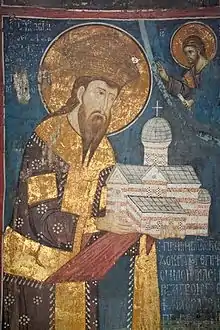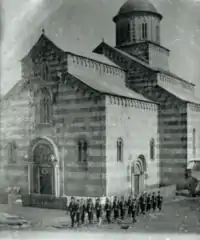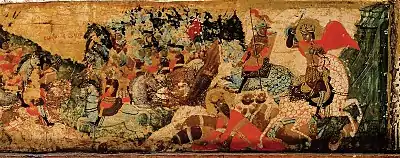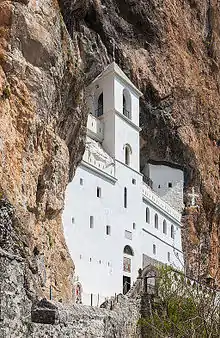Visoki Dečani
Visoki Dečani (Serbian Cyrillic: Високи Дечани) or simply Dečani (Дечани; pronounced [dɛ̌t͡ʃani]), is a medieval Serbian Orthodox Christian monastery located near Deçan, Kosovo.[lower-alpha 1] It was founded in the first half of the 14th century by Stefan Dečanski, King of Serbia.
_-_by_Pudelek..jpg.webp) Visoki Dečani Church | |
 Location of Visoki Dečani within Kosovo | |
| Monastery information | |
|---|---|
| Order | Serbian Orthodox |
| Established | 1327–35 |
| Diocese | Eparchy of Raška and Prizren |
| People | |
| Founder(s) | King Stefan Dečanski |
| Abbot | Sava Janjić |
| Important associated figures | Stefan Dečanski, Stefan Dušan |
| Architecture | |
| Style | Serbo-Byzantine style |
| Site | |
| Location | Dečani, Kosovo[lower-alpha 1] 661 m (2,168.6 ft) |
| Coordinates | 42°32′48.9984″N 20°15′57.999″E |
| Public access | yes |
| Website | https://www.decani.org |
| Official name | Medieval Monuments in Kosovo |
| Type | Cultural |
| Criteria | ii, iii, iv |
| Designated | 2004 (28th session) |
| Reference no. | 724 |
| State Party | Serbia |
| Region | Europe and North America |
| Official name | Манастир Дечани |
| Type | Monument of Culture of Exceptional Importance |
| Designated | 1947 |
| Reference no. | СК 1368[1] |
The Visoki Dečani monastery is located by the Dečanska Bistrica river gorge at the foot of the Prokletije Mountains, in the region of Metohija.[2][3] It is located about 2 kilometres (1.2 mi) from the town of Dečan.[4] The monastery is managed by the Serbian Orthodox Eparchy of Raška and Prizren. The monastery has been under the legal protection of Serbia since 1947[2] with a designation of Cultural Monument of Exceptional Importance. The monastery is part of the World Heritage site named "Medieval Monuments in Kosovo".
History

Construction began during the reign of Serbian King Stefan Dečanski in 1327 and the original founding charter from 1330 has been preserved.[5] Dečanski's son, Stefan Dušan, seized the Serbian throne in 1331 and had his father strangled to death in the Zvečan Fortress shortly afterwards. Dečanski was buried in the still incomplete Visoki Dečani monastery in 1331 and its construction was continued by Dušan.[6] The monastery's main architect was the Franciscan friar Vito of Kotor.[6][4] According to Branislav Pantelić, the monastery represents the last phase of the Western, Gothic,[7] Byzantine-Romanuesque architecture and contains Byzantine paintings and numerous Romanseque sculptures, part of a "Palaeologan renaissance".[8]
Construction of the monastery lasted for a total of 8 years, and ended in 1335. The wooden throne of the hegumen (monastery head) was finished at around this time, and the church interior was decorated. Dečanski's carved wooden sarcophagus was finished in 1340.[5] Serbian princess and Bulgarian empress consort Ana-Neda (d. ca. 1350) was buried in the church.[9]
15th–19th century

Bulgarian writer Gregory Tsamblak, author of the Life of Stefan Dečanski, was the hegumen (monastery head) at the beginning of the 15th century. The painter-monk Longin spent two decades in the monastery during the second half of the 16th century and created 15 icons with depictions of the Great Feasts and hermits, as well as his most celebrated work, the icon of Stefan Dečanski. In the late 17th century, the Ottomans plundered the monastery, but inflicted no serious damage.[5] In 1819, archimandrite Zaharija Dečanac became Metropolitan of Raška and Prizren.
20th and 21st century
During World War I, the monastery's treasures were plundered by the Austro-Hungarian Army, which occupied Serbia between 1915 and 1918.[10] The monastery fell within the territory of the Italian-ruled Albanian Kingdom during World War II, and was targeted for destruction by the Albanian nationalist Balli Kombëtar and Italian fascist blackshirts in mid-1941. The Royal Italian Army responded by sending a group of soldiers to help protect the monastery from attack.[11][12]

The monastic treasure was exhibited in the rebuilt medieval refectory in 1987.[2] The monastery's monks sheltered refugees of all ethnicities during the Kosovo War, which lasted from March 1998 to June 1999.[3] On 7 May 1998, the corpses of two elderly Albanians were found 400 metres (1,300 ft) from the monastery. They were reportedly killed by the Kosovo Liberation Army (KLA) for allegedly collaborating with Serbian forces. The KLA staged an attack not far from the monastery on 8 May, killing one person and wounding four others. That evening, Dečani's 300 remaining Serbs came to the monastery to seek shelter.[13]
Albanian civilians seeking refuge in the monastery returned to their homes following the withdrawal of Serbian military from Kosovo in June 1999. An Italian unit of the Kosovo Force (KFOR) was subsequently assigned to guard the monastery, which was attacked on several occasions.[12] Dozens of Romanis sought sanctuary in the monastery over the next several months, fearing retaliatory attacks by their Albanian neighbours, who accused them of collaborating with the Serbs and looting Albanian homes.[14]

During the violent unrest in Kosovo on 17 March 2004, KFOR defended the monastery from an Albanian mob trying to throw Molotov cocktails at it. Several Albanians were shot and wounded in the clash.[15] On 2 July 2004, the monastery was declared a World Heritage Site by the United Nations Educational, Scientific and Cultural Organization (UNESCO).[4] UNESCO cited it as "an irreplaceable treasure, a place where traditions of Romanesque architecture meet artistic patterns of the Byzantine world."[3] The monastery, along with all other Serbian Medieval Monuments in Kosovo, was added to the UNESCO list of endangered World Heritage sites in 2006.[5]
Suspected Kosovo Albanian insurgents hurled hand grenades at the monastery on 30 March 2007, but caused little damage. In recent years, the situation around the monastery has stabilized and it has reopened to visitors.[3] Serbian President Boris Tadić attended a service at the monastery in April 2009.[16] U.S. Vice President Joe Biden visited the monastery the following month.[17] In the annual International Religious Freedom Report, the State Department wrote that the Deçan municipal officials continued to refuse to implement a 2016 Constitutional Court decision upholding the Supreme Court’s 2012 ruling recognizing the monastery’s ownership of approximately 24 hectares of land.[18]
Architecture


The church has five-nave naos, a three-part iconostasis, and a three-nave parvise. With the dome, it is 26 m high. Its outer walls are done in alternate layers of white and pink marble. The portals, windows, consoles, and capitals are richly decorated. Christ the Judge is shown surrounded by angels in the western part of the church. Its twenty major cycles of fresco murals represent the largest preserved gallery of Serbian medieval art, featuring over 1000 compositions and several thousand portraits.
Heritage site in danger
Dečani Monastery is one of four World Heritage medieval monuments in Kosovo designated as a heritage site in danger. Since the arrival of KFOR peacekeepers in the region in 1999, attacks on the Monastery have increased. Since 1999 there have been five significant attacks and near miss attacks on the monastery:
- 27 February 2000 – Six grenades hit the Decani Monastery.[19]
- 22 June 2000 – Nine grenades hit the Decani Monastery.[20]
- 17 March 2004 – Seven grenades fell around the monastery walls.[21] This attack formed part of the 2004 unrest in Kosovo.
- 30 March 2007 – One grenade hit the wall behind the church.[22][19]
- 1 February 2016 – Four armed suspects in a motor vehicle were detained at the gates of the monastery. A search of their car found an assault rifle, pistol, ammunition and extremist Islamist printed material. It is unclear whether there is any connection between the case of Decani and an earlier attack in a mosque in Drenas.[23] Dusan Kozarev, member of government of Serbia had claimed a year earlier that the monastery gates were painted with graffiti that read "ISIS", "Caliphate is coming" and "UCK".[24]
Dečani Monastery is currently under 24/7 guard from KFOR. Of the four medieval monuments in Kosovo that are designated as a heritage site in danger, Dečani is the only one under direct guard from KFOR.
In popular culture
Visoki Dečani, three episodes of the documentary series "Witnesses of Times" produced by the broadcasting service RTB in 1989 was created by PhD Gordana Babic and Petar Savković, directed by Dragoslav Bokan, music was composed by Zoran Hristić.[25]
Other burials
See also
Annotations
- Kosovo is the subject of a territorial dispute between the Republic of Kosovo and the Republic of Serbia. The Republic of Kosovo unilaterally declared independence on 17 February 2008. Serbia continues to claim it as part of its own sovereign territory. The two governments began to normalise relations in 2013, as part of the 2013 Brussels Agreement. Kosovo is currently recognized as an independent state by 98 out of the 193 United Nations member states. In total, 113 UN member states recognized Kosovo at some point, of which 15 later withdrew their recognition.
References
- Serbian Academy of Sciences and Arts 2006.
- World Heritage Committee 2003.
- Burke & March 2009.
- Elsie 2010, p. 72.
- UNESCO 2006.
- Judah 2000, p. 23.
- Walter, Branislav Pantelić, Christopher (2003). Branislav Pantelić, The Architecture of Decani and the Role of Archbishop Danilo II. pp. 257–258. Retrieved 25 March 2020.
- DEČANI MONASTERY NOMINATION OF THE CULTURAL MONUMENT FOR INCLUSION ON THE WORLD HERITAGE LIST (PDF). Kosovo: UNESCO World Heritage. 2004. pp. 32–33, 122–123, 141, 143, 146–147. Retrieved 25 March 2020.
- Mile Nedeljković (2002). Srpski običajni kalendar: za prostu 2003. godinu. Čin. p. 180.
- Mitrović 2007, p. 230.
- Judah 2000, p. 131.
- Judah 2002, p. 287.
- Judah 2002, p. 158.
- Judah 2002, p. 288.
- King & Mason 2006, p. 14.
- BBC & 17 April 2009.
- Tanner & 22 May 2009.
- State Department 2020.
- "Decani Monastery Attacked Four Times Between 2000–2007". Greek Orthodox Archdiocese of America. Retrieved 27 November 2017.
- "News from Kosovo". Serbian Orthodox Diocese of Raska and Prizren. Retrieved 27 November 2017.
- "Cultural Heritage in South-East Europe: Kosovo" (PDF). UNESCO. Retrieved 27 November 2017.
- "International Religious Freedom Report 2009". US Department of State. Retrieved 6 October 2009.
- "Kosovo Gunmen Arrested Near Serb Monastery". Balkan Insight. 1 February 2016. Retrieved 1 February 2016.
- "Remarks by Mr Dusan Kozarev, office for Kosovo and Metohija, Government of Serbia made at the Human Dimensions Implementation Meeting in Warsaw". Office for Kosovo and Metohija (Serbia). 30 September 2015.
- Visoki Dečani – first episode on YouTube Official channel of RTS;Visoki Dečani – second episode on YouTube Official channel of RTS;Visoki Dečani – third episode on YouTube Official channel of RTS
Sources
- "Serbian president visits Kosovo". BBC. 17 April 2009.
- Burke, Kathleen (March 2009). "Endangered Site: Visoki Decani Monastery, Kosovo". Smithsonian Magazine.
- Elsie, Robert (2010). Historical Dictionary of Kosovo. Lanham, Maryland: Rowman & Littlefield. ISBN 978-0-8108-7483-1.
- Judah, Tim (2000). The Serbs: History, Myth and the Destruction of Yugoslavia (2nd ed.). New Haven, Connecticut: Yale University Press. ISBN 978-0-300-08507-5.
- Judah, Tim (2002). Kosovo: War and Revenge. New Haven, Connecticut: Yale University Press. ISBN 978-0-300-09725-2.
- King, Ian; Mason, Whit (2006). Peace at Any Price: How the World Failed Kosovo. Ithaca, New York: Cornell University Press. ISBN 978-0-8014-4539-2.
- Mitrović, Andrej (2007). Serbia's Great War, 1914–1918. West Lafayette, Indiana: Purdue University Press. ISBN 978-1-55753-477-4.
- "Visoki Dečani". Serbian Academy of Sciences and Arts. 2006.
- Tanner, Adam (22 May 2009). "Biden visit to Kosovo monastery splits Serbian Orthodox Church". Reuters.
- "Medieval Monuments in Kosovo". UNESCO. 2006.
- "Dečani (Serbia–Montenegro)" (PDF). World Heritage Committee. 2003.
- "2019 Report on International Religious Freedom: Kosovo". United States Department of State. 2020.
Further reading
- Antić, Ivana. Das Kloster Visoki Dečani. Manastir Visoki Dečani, 2008.
- Burke, Kathleen. "VISOKI DECANI MONASTERY, KOSOVO A Medieval Refuge." SMITHSONIAN 39.12 (2009): 46–47.
- Babić, Gordana (1995). Djurić, Vojislav J. (ed.). "Zidno slikarstvo manastira Decana: grada i studije". Belgrade: SANU. Cite journal requires
|journal=(help) - Ćirković, Sima (2004). The Serbs. Malden: Blackwell Publishing. ISBN 9781405142915.
- Đorđević, Života; Pejić, Svetlana, eds. (1999). Cultural Heritage of Kosovo and Metohija. Belgrade: Institute for the Protection of Cultural Monuments of the Republic of Serbia.
- Ferrari, Silvio; Benzo, Andrea (2014). Between Cultural Diversity and Common Heritage: Legal and Religious Perspectives on the Sacred Places of the Mediterranean. London & New York: Routledge. ISBN 9781317175032.
- Grozdanović-Pajić, Miroslava; Stanković, Radoman (1995). "Rukopisne knjige manastira Visoki Dečani: Vodeni znaci i datiranje". Narodna biblioteka Srbije. Cite journal requires
|journal=(help) - Ivić, Pavle, ed. (1995). The History of Serbian Culture. Edgware: Porthill Publishers.
- KESIC-RISTIC, Sanja, and Dragan VOJVODIC. "Zidno slikarstvo manastira Decana: grada i studije; La peinture murale du monastère de Decani: matériaux et études; Beograd; Srpska akademija nauka i umjetnosti Menolog." (1995).
- Krstić, Branislav (2003). Saving the Cultural Heritage of Serbia and Europe in Kosovo and Metohia. Belgrade: Coordination Center of the Federal Government and the Government of the Republic of Serbia for Kosovo and Metohia.
- Marković, Miodrag; Vojvodić, Dragan, eds. (2017). Serbian Artistic Heritage in Kosovo and Metohija: Identity, Significance, Vulnerability. Belgrade: Serbian Academy of Sciences and Arts.
- Pantelić, Bratislav (2002). The Architecture of Dečani and the Role of Archbishop Danilo II. Wiesbaden: Reichert. ISBN 9783895002397.
- Peić, Sava (1994). Medieval Serbian Culture. London: Alpine Fine Arts Collection.
- Petković, Vesna; Peić, Sava (2013). Serbian Medieval Cultural Heritage. Belgrade: Dereta.
- Ristanović, Petar R. "Guestbook of monastery Visoki Decani: 1924–1945: As historical source." Baština 39 (2015): 171–188.
- Šakota, Mirjana (2017). Ottoman Chronicles: Dečani Monastery Archives. Prizren: Diocese of Raška-Prizren.
- Samardžić, Radovan; Duškov, Milan, eds. (1993). Serbs in European Civilization. Belgrade: Nova, Serbian Academy of Sciences and Arts, Institute for Balkan Studies. ISBN 9788675830153.
- Sindik, N. (2011). Bogdanović, D.; et al. (eds.). "Opis ćirilskih rukopisnih knjiga manastira Visoki Dečani" [Description of Cyrillic Manuscripts From Monastery Visoki Dečani]. Opis Južnoslovenskih ćirilskih Rukopisa. Belgrade: Narodna biblioteka Srbije. 4.
- Subotić, Gojko (1998). Art of Kosovo: The Sacred Land. New York: The Monacelli Press. ISBN 9781580930062.
- Todić, Branislav; Čanak-Medić, Milka (2013). The Dečani Monastery. Belgrade: Museum in Priština. ISBN 9788651916536.
- Živković, Tibor; Bojanin, Stanoje; Petrović, Vladeta, eds. (2000). Selected Charters of Serbian Rulers (XII-XV Century): Relating to the Territory of Kosovo and Metohia. Athens: Center for Studies of Byzantine Civilisation.
External links
| Wikimedia Commons has media related to Visoki Dečani. |


